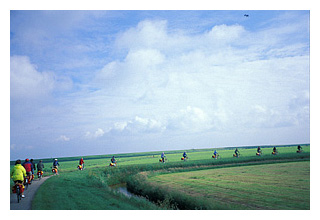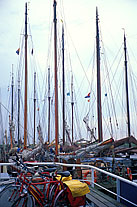
Last bike tripJuly 1997
Bicycle Touring in The Netherlands: Around the Ijsselmeer
Cycle on quiet roads, self-organized, or with a commercial bike tour.
Bike Rating: Very Good
Nature of the Ride:The IJsselmeer (pronounced Eye-ssel-mar) is a huge man-made lake of 1,380 square miles, the biggest in Western Europe. Formed out of the ancient Zuider Zee, it lies just north and east of Amsterdam, which, in the 19th century, was on its shore.
You may cycle the IJsselmeer area either by using a tour ship for overnight lodging and as base for daily outings; or as a self-guided circuit of 250-350 kilometers (150 - 210 miles). As you might expect, there is nary a hill, unless you consider an easy climb of 15 feet, from one dike level to another, a hill. The wind can be another story, and some rain is likely. Although there are well-signed bicycle paths near Amsterdam, most of your biking will be in rural farmland, upon highways, roads, country lanes, and town streets with light or light to moderate traffic.
History: Before the late 13th century, this region was composed of a series of freshwater lakes along the IJssel river. A climate change, possibly, or perhaps the massive harvesting of peat, which served as a barrier to the tides, weakened the resistance of the fresh water to the salt water of the sea. In any event, a massive tidal wave in the year 1287 allowed the sea to encroach; existing vegetation died off or was washed away; and by the 14th century the entire area had become a shallow branch of the North Sea.
 Amsterdam
became a rich and famous city, as its boats (and those from other shore
towns) sailed the newly created Zuider Zee to ply a trade, first
to Scandinavia and the Baltic states, and later to the Orient. The Zuuider
Zee shore became known as "The Golden Circle". The downside
was that towns along the shore were, for centuries, ravished by devastating
floods.
Amsterdam
became a rich and famous city, as its boats (and those from other shore
towns) sailed the newly created Zuider Zee to ply a trade, first
to Scandinavia and the Baltic states, and later to the Orient. The Zuuider
Zee shore became known as "The Golden Circle". The downside
was that towns along the shore were, for centuries, ravished by devastating
floods.
By the late 19th century, a protective dike closed Amsterdam off from the IJsselmeer, and surrounding lands were filled to accommodate the growth of the city. In 1932, the Netherlands completed a 19 miles-long barrier dam-dike (Afsluitdijk), blocking off the northern entrance into the Zuider Zee, renamed the IJsselmeer.
As was planned, the Dutch, by damming and draining, reclaimed several huge polder (new agricultural lands) from the edges of the lake, decreasing its surface by almost one-half. The following URL shows a beautiful and informative satellite picture of the area: http://edcwww.cr.usgs.gov/earthshots/slow/IJsselmeer/IJsselmeer. Click on the "annotated 1973 map".
When to go: The best time to cycle in the IJsselmeer is in July and August, when the average temperature is near Amsterdam is above 70 F. June and September are about 3 degrees F cooler (2 degrees C). These are averages, and some days will be warm and pleasant, while others will be chilly. At the north end of the lake, the temperatures will be much cooler, as you will border the North Sea.
Attractions: Good reasons for going on this ride are: the chance to learn about Dutch rural life and culture; to understand the nature of reclamation, dikes, and polders, and the history of the struggle with the sea; to enjoy the sight of some sparklingly clean, charming towns with row houses by the street — all with their window shades open, and collections of objects in view; and to see boats, windmills, a monastery, a castle, historical museum and galleries. There are noticeable differences in feeling between the countryside in Holland (i.e., near Amsterdam), and the lands on the far side of the lake. The area south of the lake, and north of Utrecht, has yet another feeling, with higher ground, and larger, more wealthy homes set on lawns.
The Michelin green guide rates the following towns on the lake as one star: Marken, Volendam, Hoorn, Enkhuizen, Bolsward,Sloten, Urk and Muiden, and gives the Afsluitdijk dam, which closes off the lake from the ocean, two stars. Amsterdam***, the likely start and end of your tour, merits a visit of several days.
Please refer to Bicycle Touring in Europe for important background on touring styles, transportation, bike types, rentals, maps, information sources, traffic ratings, packing, and security and safety tips. Star symbols in the text show ratings given by the Michelin green guide books, which the author likes and uses. Three stars mean worth a journey; two, worth a detour; and one, interesting.
Tip: At night, do not leave a good bicycle on the street in central Amsterdam or elsewhere, even locked. Bring it into the courtyard or storage room of your hotel. In the day, in Amsterdam, be sure to lock your bicycle very securely to a fixed object, and lock or remove any detachable parts. You will see many unlocked city bikes (with no gears), but these are often treated as "social property" and "borrowed" from one person to another as needed. This site gives you some flavor of the problem: http://www.phys.uu.nl/~esn/utrecht/utr_city/bike_repairman.html.
How to bike it: Self-organized circuit around the lake; or organized, self-guided circuit; or organized tour on boat, with very basic cabins, breakfast and dinner on boat.
The author's trip was by boat, using the tour company now called Cycletours Holland, whose URL is http://www.cycletours.com. The cabins on the author's boat were minuscule but adequate, with shower and toilet. The food was ample and tasty, but basic, of the meat and potatoes and pasta type, and far from gourmet. The guide was helpful and informative. Cycletours' price per person for a week-long cycling trip was, and is, extremely reasonable.
Cycletours can also arrange week-long, very economical, self-guiding trips around the IJsselmeer with baggage transportation between hotels, and detailed itineraries.
Clicking on any picture |
|
 |
|
Masts, Hoorn. |
|
 |
|
Cyclists in lakeside town. |
|
 |
|
Dike near Hindeloopen. |
|
 |
|
Morning coffee stop. |
|
 |
|
Historical museum on what used to be a tiny island in the IJsselmeer
|
|
 |
|
Touring lady biker in the rain. |
|
 |
|
Bicycle path marker in the woods
|
|
 |
|
Muiden castle. |
Organizing the Trip Yourself:Distance and Time: You can undertake a complete circuit around the IJsselmeer, self-guided, 150 to 210 miles (250 to 350 kilometers) long, depending on routing and detours, in five to nine days. Starting and Ending Points: Amsterdam railway station. The Schipol Airport is about 15 kilometers from the railway station; most hotels are within 3 kilometers of the railway station. A network of bicycle paths connects everything. Itinerary: You should choose yorself the specific overnight stops you wish to make, depending upon how long you wish to ride each day, how much you enjoy poking around the towns, and how much you wish to visit sights such as windmills and museums. In July and August, you will need to reserve your hotels in advance. Obtain the VVV/ANWB maps with bike paths from one of their many offices in the Netherlands or from a Internet map store (1:100,000 or 1:50,000), and plot out your route using bike paths and minor roads. The Dutch Tourist Offices can also provide information on local attractions. Their web site in English is at: http://www.holland.com. This site also has a very effective search engine for making hotel reservations in different cities and with different prices and service levels. Another site that will be very helpful in planning a detailed itinerary is: http://www.goldencircle.nl/index2.html, which has information in English on towns and on tourist sites all around the IJsselmeer. For basic information about cycling in the Netherlands, see these sites: http://www.hsa.lr.tudelft.nl/~bvo/fiets/nlbybike.htm, http://www2.holland.com/global/discover/active/cycling/. Assuming you will follow a clockwise itinerary, and will be starting your trip from the Amsterdam area, the following is a possible itinerary: Day 1: Amsterdam***, Marken* (picturesque ex-island village on the end of a penninsula), Volendam* (picturesque village, traditional costumes in summer), Edam (cheese market, cheese exhibit, church), Hoorn* (important seaport, many interesting homes, squares, West Friesland Museum) — 40-50 kilometers from central Amsterdam. Day 2: Hoorn*, Enkhuizen*(17th century facades, Dromedaris tower with panorama, Zuiderzee Museum*, Outdoor Museum** recreating daily life a century ago), Medemblik (Oosterhaven*, Radbod castle) — 36 kilometers or on to Hippolytushoef, about 55 kilometers. Day 3: Medemblik, Afsluidijk**(barrier dam), Makkum (pottery) — about 50 kilometers, or on to Workum, 65 kilometers, or Bolsward*(townhall*, church), about 60 kilometers. You may take a30 kilometer detour, each way, to Leuwarden*, the capital of Friesland. This larger town has a palace and several fine museums, as well as interesting residences and shops. Day 4: Makkum, Workum, Hindeloopen, Stravoren, Balk, Sloten* (an old fortified city with 17th and 18th century houses), Lemmer — about 50kilometers. Day 5: Lemmer, Urk* (once an island before the creation of the northeast polder), Schokland (between Ens and Nagele, a former island in the Zuiderze, with a small museum), Kampen*(charming town with many sights, see the interior of town hall=Oude Raadhuis) — about 44 kilometers. You may take a detour of 35 kilometers total, or an alternative route to that given above, about 60 kilometers in total, to the lakes and nature area near Giethoorn. Day 6: Kampen*, Elburg , Harderwijk, and perhaps on to Amersfoort* (larger town with many sights for up to one-half day, including several market areas, St. Georges Church, the port, and the Koppel Gate*), alternatively to the charming waterside town of Bunschoten* — about 60 kilometers. If you are an art lover, you may take a detour of about 70 kilometers, adding an extra day, through hilly (for the Netherlands) woodlands to the Het Loo** Royal Palace Museum near Apeldooorn, and the Kröller Muller National Museum of Art*** in the Hoge Veluwe National Park**. Stay in Apeldoorn. Day 7: Amersfoort* or Bunschoten* to Amsterdam*** — about 50 kilometers. The residential suburbs of Hilversum, Laren and Blaricum have many expensive houses with nice lawns. Muiden*, on the coast, has an interesting castle that is worth a short visit. From Muiden* to central Amsterdam*** you have a choice of bike routes. To List of Best European Bike Tours |